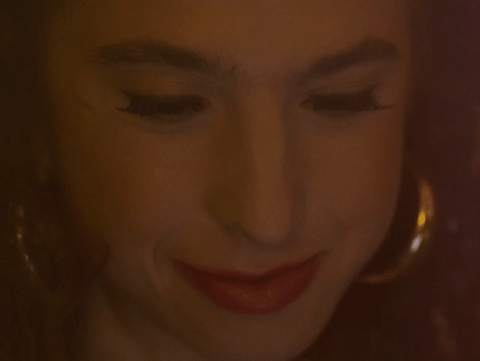

“Come spank me in Niagara,” a young woman says, cocking her orange curls to the side. The light in the room is hazy and dim. A man responds, through the screen of her computer, with laughter. He isn’t coming to Niagara. He has to pick up his kids in twenty minutes. It’s just a preliminary meeting, through the protective mediation of their devices, before they decide whether they want to pursue an arrangement in person. She seems hurt, but the camera doesn’t linger on her face enough to say for sure. Shortly after, the voice coming across the line is an old woman’s, a regular seeking simple company. Becca Willow Moss, a young multidisciplinary artist from Toronto, spends a lot of time on calls with her clients, “lonely people deserving companionship,” as she explains to one of the men she met online. Sometimes she strips for men like him, other times she serenades elderly folks just looking for a friend. One of the faceless online men tells her all care—though he is referring to sexual satisfaction—is about personalization, the custom attention that comes only from careful listening. “It’s what each person needs,” he says.
So goes the title of a new short film by Sophy Romvari that collapses the boundaries between two types of ministration—sex work and companion care—capturing Moss in various conversations with either type of caller. “To me, on the surface, sex work and singing to the elderly are just different modes of meeting someone else’s needs,” Romvari said. In between these gestures, as the phones ring and days turn to nights, nights back to mornings, we get a glimpse of Moss’s own isolation. No one appears to fulfill the same needs for her.
A few years ago, Moss, moved by other work that Romvari had made depicting, as Romvari put it, “lonely girls on laptops,” approached the filmmaker to collaborate. Moss wanted Romvari to capture her virtual encounters; Romvari wanted to explore what they might mean about the performance of the self for others. Romvari was wary of observational portraiture; her earlier work was exclusively personal, and didn’t attempt to characterize another subject (“except for a couple of films about dogs”). She knew the camera could not take a neutral stance. But she also realized that she could use the form to explore reciprocity—not just in Moss’s working relationships but also in their own, as subject and filmmaker. “The title also speaks to what I was doing for Becca, and what Becca was doing for me,” she said, acknowledging that, in order to execute her creative vision, she would have to negotiate with Moss, who had her own ideas about how she wanted to be portrayed. “I sometimes feel when people appear in documentaries, they don’t always know what they’re consenting to.”
In one of the final conversations, Moss’s mobile interlocutor is not a Jewish grandmother or prospective patron but Romvari herself. The director has remained largely silent and invisible, executing her subjectivity through visual language, but now she breaks the story’s veneer to challenge its perspective. Throughout the film, viewers can’t help but make their own assumptions about Moss, filling gaps in the narrative about what she is doing, or why. Finally, Romvari goes straight to the source, and asks Moss what she thinks the film is about. After a long pause, Moss collects herself, and offers an answer that denudes the vulnerability at the heart of her labor.
The Inner Life of an Internet Companion in “It’s What Each Person Needs”
Source: News Flash Trending





0 Comments